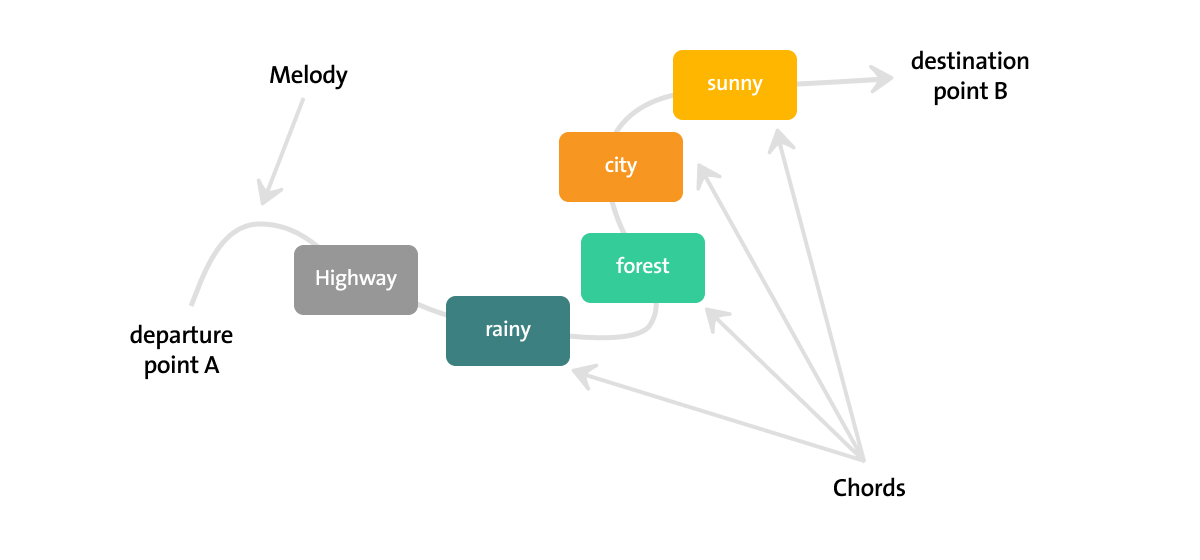At Chordify, we provide you with the chords for songs you wanna play. So, chords are our core value. And if you play piano, guitar or ukulele, the word “chord” is probably one of the earliest terms you became familiar with. This article is devoted to the definition of a chord as a musical phenomenon.
Definition of a chord
Simply put, the chord is a combination of at least three different sound pitches sounding simultaneously.
What does a chord do in music?
Chords create a musical environment and mood, making you feel something!
Imagine you’re going from point A to point B by car and you take a certain route. Your route may pass through a forest or a big city. The weather can change from rainy and cloudy to sunny. All these things create a certain environment for the journey, affecting your mood.
If this example is transferred to music, then the road you are driving is a melody and the elements accompanying your journey (such as weather, terrain) are chords. Historically, chords have emerged as support of the melody.
Types of chords
There are so many different chords out there! Remember that chords put us in a certain mood. So, let’s divide chords into two big groups – happy and sad chords.
Major chords – chords which we’ll more likely perceive as happy and positive.
Minor chords – chords sounding melancholic and sad to our ears.
In the picture below you can see the most common chord types.
Major and minor triads are some of the most popular chords. You can hear them in many, many songs. We have a special paragraph about triads later in this article.
How is a chord’s symbol formed?
Chords are denoted by a capital Latin letter corresponding to the first note of the chord – the root of the chord. This letter can also be followed by a sharp or flat symbol, in case the root note of the chord is a sharp or flat note.
In the case of a minor chord, a small “m” is also added.
Let’s see a few examples:
C – C major chord;
C# – C sharp major chord;
Em – E minor chord;
Ebm – E flat minor chord.
All these chords from the examples are triads, consisting of only three different notes. We’ll talk more about triads in the following paragraph. Of course, a chord can have more than three notes – for instance, four notes in the case of 6th or 7th chords. Then this number (6 or 7) is also added at the end.
C7 – C dominant seventh chord;
C#6 – C sharp major sixth chord;
Em7 – E minor seventh chord;
Ebm6 – E flat minor sixth chord.
Let’s sum everything up! You can see all the parts of the chord’s symbol in the picture below:
Note that there are also altered chords. In this case, an altered note is added at the end. We don’t talk about altered chords in this article though, since they deserve a special write up.
Major and minor triads
Major and minor triads are the basis for many very popular chords. A major or minor triad is a chord, consisting of only three different notes (different sound pitches):
1st note – root note – the first note from the chord.
2nd note – minor / major third – a note, located a minor / major third interval above the root note.
3rd note – a note, located the perfect fifth interval above the root note.
Let’s find a C major triad. We need to pick up the first (root) note and find notes located a major third and perfect fifth intervals above the root note.
The 1st note (root note of the C major triad) is the C note.
The 2nd note – calculating a major third from the C note, we get the E note.
The 3rd note – calculating a perfect fifth from the C note, we get the G note.
Therefore, the C major triad will consist of C, E and G notes. You can see an example of the C major triad on piano in the picture below.
So you play guitar? Here’s how you can play the C major triad in three simple steps on your six string.
Let’s find a D minor triad by following the same steps as in the example above.
The 1st note (root note of the D minor triad) is the D note.
The 2nd note – calculating a minor third from the D note, we get the F note.
The 3rd note – calculating a perfect fifth from the D note, we get the A note.
Therefore, the D minor triad will consist of D, F and A notes. You can see an example of the D minor triad on piano in the picture below.
If you want to jam this chord on your ax, just check out the video below where we explain how in three simple steps.
The order of notes in a triad can be changed. So far, we talked about this order: root, 3rd and 5th, but it also can be – 3rd, 5th, root; 5th, root, 3rd. This phenomenon in music is called an inversion. You can read our special article about inversions.








